Bowen He
Improving Audio-Visual Segmentation with Bidirectional Generation
Aug 16, 2023Abstract:The aim of audio-visual segmentation (AVS) is to precisely differentiate audible objects within videos down to the pixel level. Traditional approaches often tackle this challenge by combining information from various modalities, where the contribution of each modality is implicitly or explicitly modeled. Nevertheless, the interconnections between different modalities tend to be overlooked in audio-visual modeling. In this paper, inspired by the human ability to mentally simulate the sound of an object and its visual appearance, we introduce a bidirectional generation framework. This framework establishes robust correlations between an object's visual characteristics and its associated sound, thereby enhancing the performance of AVS. To achieve this, we employ a visual-to-audio projection component that reconstructs audio features from object segmentation masks and minimizes reconstruction errors. Moreover, recognizing that many sounds are linked to object movements, we introduce an implicit volumetric motion estimation module to handle temporal dynamics that may be challenging to capture using conventional optical flow methods. To showcase the effectiveness of our approach, we conduct comprehensive experiments and analyses on the widely recognized AVSBench benchmark. As a result, we establish a new state-of-the-art performance level in the AVS benchmark, particularly excelling in the challenging MS3 subset which involves segmenting multiple sound sources. To facilitate reproducibility, we plan to release both the source code and the pre-trained model.
Toeplitz Neural Network for Sequence Modeling
May 08, 2023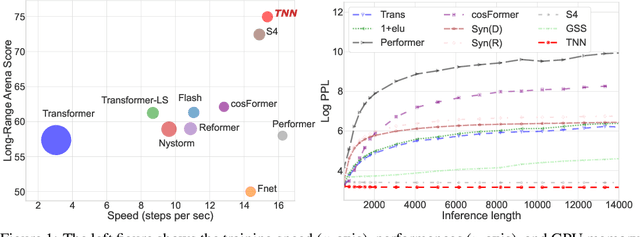

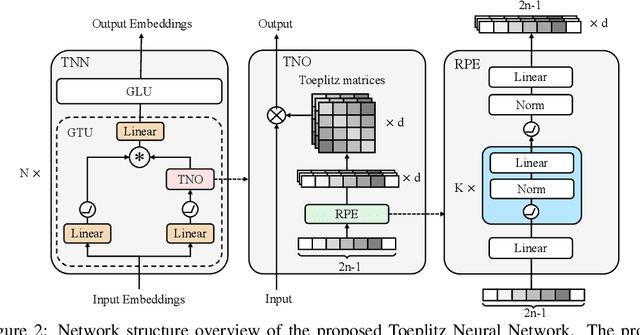
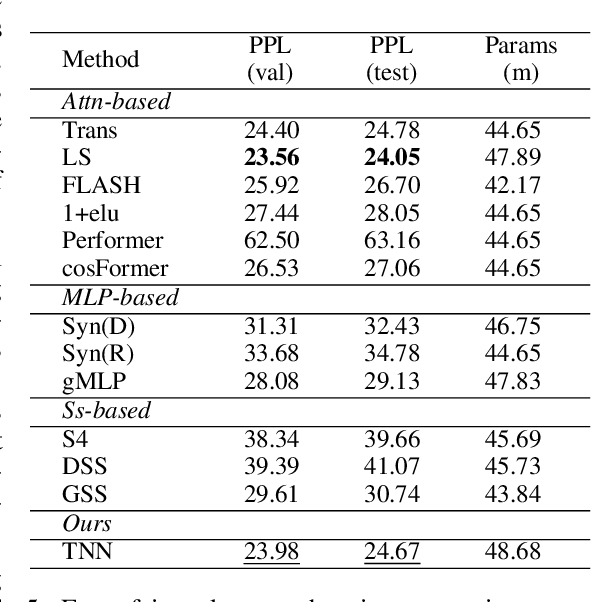
Abstract:Sequence modeling has important applications in natural language processing and computer vision. Recently, the transformer-based models have shown strong performance on various sequence modeling tasks, which rely on attention to capture pairwise token relations, and position embedding to inject positional information. While showing good performance, the transformer models are inefficient to scale to long input sequences, mainly due to the quadratic space-time complexity of attention. To overcome this inefficiency, we propose to model sequences with a relative position encoded Toeplitz matrix and use a Toeplitz matrix-vector production trick to reduce the space-time complexity of the sequence modeling to log linear. A lightweight sub-network called relative position encoder is proposed to generate relative position coefficients with a fixed budget of parameters, enabling the proposed Toeplitz neural network to deal with varying sequence lengths. In addition, despite being trained on 512-token sequences, our model can extrapolate input sequence length up to 14K tokens in inference with consistent performance. Extensive experiments on autoregressive and bidirectional language modeling, image modeling, and the challenging Long-Range Arena benchmark show that our method achieves better performance than its competitors in most downstream tasks while being significantly faster. The code is available at https://github.com/OpenNLPLab/Tnn.
Fine-grained Audible Video Description
Mar 27, 2023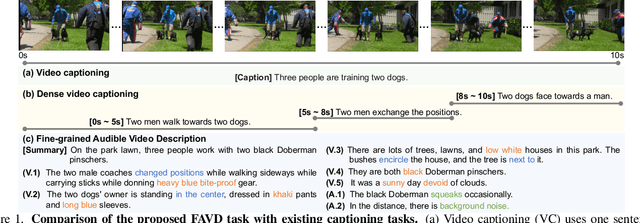


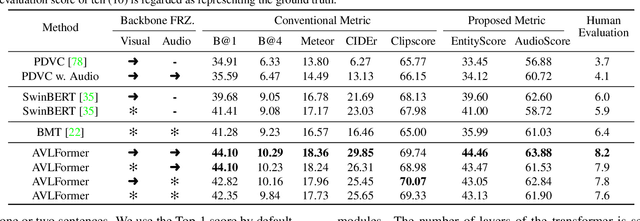
Abstract:We explore a new task for audio-visual-language modeling called fine-grained audible video description (FAVD). It aims to provide detailed textual descriptions for the given audible videos, including the appearance and spatial locations of each object, the actions of moving objects, and the sounds in videos. Existing visual-language modeling tasks often concentrate on visual cues in videos while undervaluing the language and audio modalities. On the other hand, FAVD requires not only audio-visual-language modeling skills but also paragraph-level language generation abilities. We construct the first fine-grained audible video description benchmark (FAVDBench) to facilitate this research. For each video clip, we first provide a one-sentence summary of the video, ie, the caption, followed by 4-6 sentences describing the visual details and 1-2 audio-related descriptions at the end. The descriptions are provided in both English and Chinese. We create two new metrics for this task: an EntityScore to gauge the completeness of entities in the visual descriptions, and an AudioScore to assess the audio descriptions. As a preliminary approach to this task, we propose an audio-visual-language transformer that extends existing video captioning model with an additional audio branch. We combine the masked language modeling and auto-regressive language modeling losses to optimize our model so that it can produce paragraph-level descriptions. We illustrate the efficiency of our model in audio-visual-language modeling by evaluating it against the proposed benchmark using both conventional captioning metrics and our proposed metrics. We further put our benchmark to the test in video generation models, demonstrating that employing fine-grained video descriptions can create more intricate videos than using captions.
Does DQN really learn? Exploring adversarial training schemes in Pong
Mar 20, 2022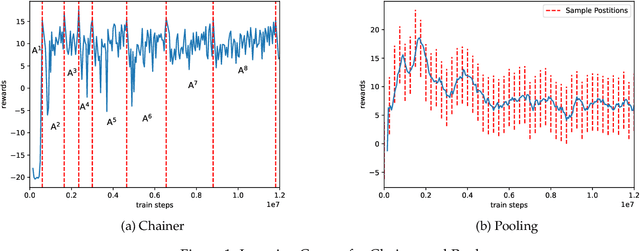
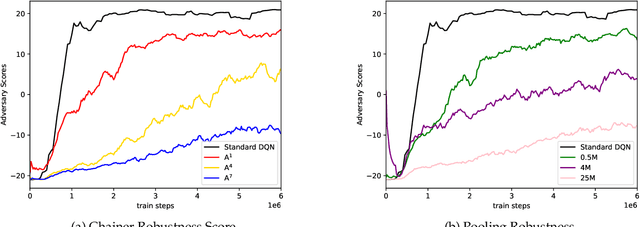

Abstract:In this work, we study two self-play training schemes, Chainer and Pool, and show they lead to improved agent performance in Atari Pong compared to a standard DQN agent -- trained against the built-in Atari opponent. To measure agent performance, we define a robustness metric that captures how difficult it is to learn a strategy that beats the agent's learned policy. Through playing past versions of themselves, Chainer and Pool are able to target weaknesses in their policies and improve their resistance to attack. Agents trained using these methods score well on our robustness metric and can easily defeat the standard DQN agent. We conclude by using linear probing to illuminate what internal structures the different agents develop to play the game. We show that training agents with Chainer or Pool leads to richer network activations with greater predictive power to estimate critical game-state features compared to the standard DQN agent.
Value-Based Reinforcement Learning for Continuous Control Robotic Manipulation in Multi-Task Sparse Reward Settings
Jul 28, 2021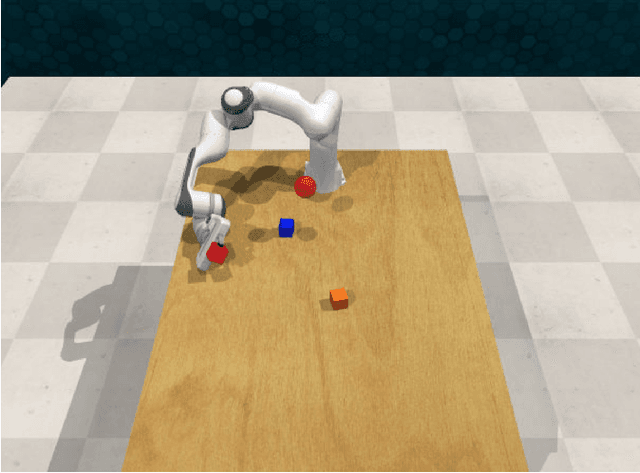

Abstract:Learning continuous control in high-dimensional sparse reward settings, such as robotic manipulation, is a challenging problem due to the number of samples often required to obtain accurate optimal value and policy estimates. While many deep reinforcement learning methods have aimed at improving sample efficiency through replay or improved exploration techniques, state of the art actor-critic and policy gradient methods still suffer from the hard exploration problem in sparse reward settings. Motivated by recent successes of value-based methods for approximating state-action values, like RBF-DQN, we explore the potential of value-based reinforcement learning for learning continuous robotic manipulation tasks in multi-task sparse reward settings. On robotic manipulation tasks, we empirically show RBF-DQN converges faster than current state of the art algorithms such as TD3, SAC, and PPO. We also perform ablation studies with RBF-DQN and have shown that some enhancement techniques for vanilla Deep Q learning such as Hindsight Experience Replay (HER) and Prioritized Experience Replay (PER) can also be applied to RBF-DQN. Our experimental analysis suggests that value-based approaches may be more sensitive to data augmentation and replay buffer sample techniques than policy-gradient methods, and that the benefits of these methods for robot manipulation are heavily dependent on the transition dynamics of generated subgoal states.
A Domain Generalization Perspective on Listwise Context Modeling
Feb 12, 2019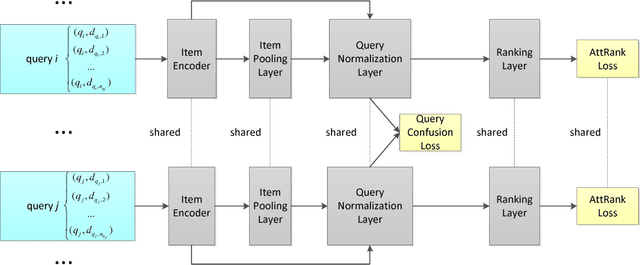


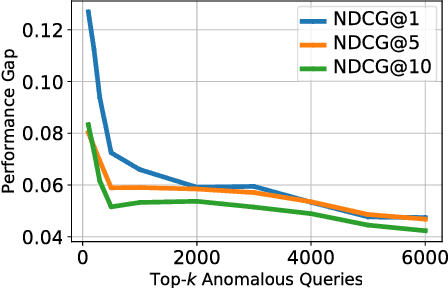
Abstract:As one of the most popular techniques for solving the ranking problem in information retrieval, Learning-to-rank (LETOR) has received a lot of attention both in academia and industry due to its importance in a wide variety of data mining applications. However, most of existing LETOR approaches choose to learn a single global ranking function to handle all queries, and ignore the substantial differences that exist between queries. In this paper, we propose a domain generalization strategy to tackle this problem. We propose Query-Invariant Listwise Context Modeling (QILCM), a novel neural architecture which eliminates the detrimental influence of inter-query variability by learning \textit{query-invariant} latent representations, such that the ranking system could generalize better to unseen queries. We evaluate our techniques on benchmark datasets, demonstrating that QILCM outperforms previous state-of-the-art approaches by a substantial margin.
 Add to Chrome
Add to Chrome Add to Firefox
Add to Firefox Add to Edge
Add to Edge